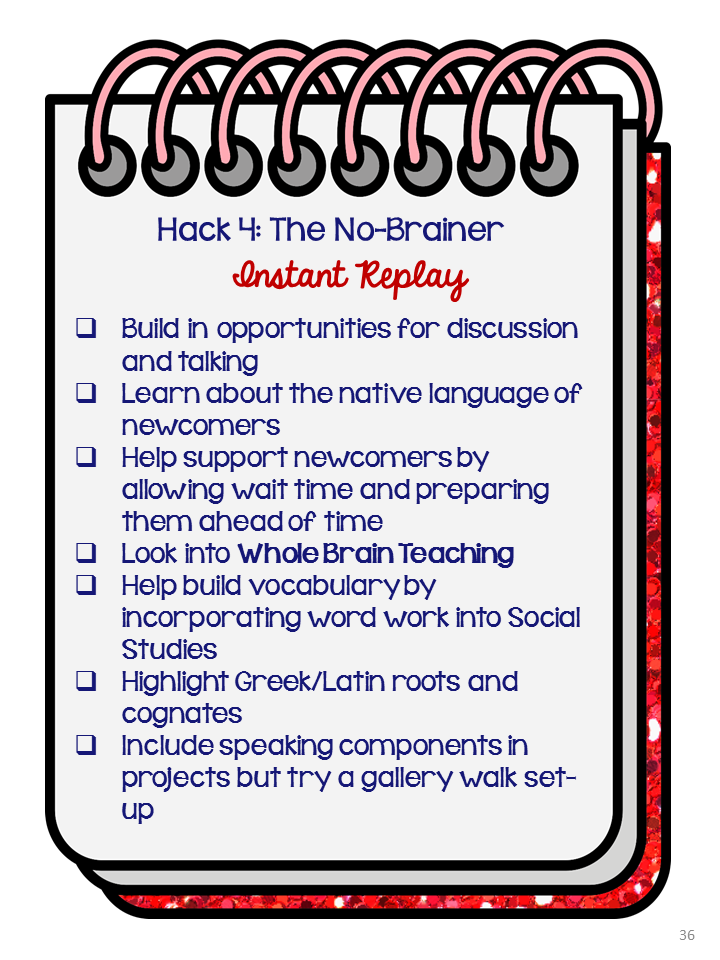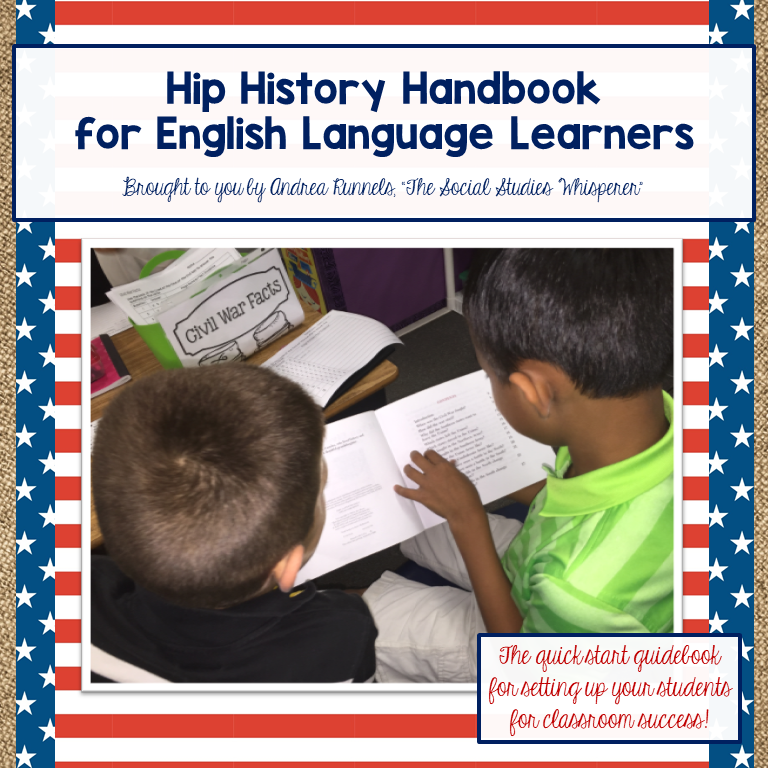Ask a teacher their number one problem during class and 9 times out of 10, it’s going to be talking! So one great strategy is to get those kids talking for good not evil. This “No-Brainer” is to help build that vocabulary and then give kids lots of chances to use it!! And guess what? English Language Learners need lots of practice to increase their expanding vocabulary. They are not going to be as likely to speak out in front of the class so if you give them opportunities to talk with partners or in small groups it’s going to really be helpful to their language development.
Your “New Teacher 101” generic turn and talk and cooperative learning opportunities are great. If possible, partner your newcomers with another child who speaks their native language. Be careful not to let the other child always speak for your newcomer. Let them gradually build their vocabulary by speaking in their native language but then encourage them to try out English. Do not push a child too soon. They are often anxious about being teased by others for having an accent.
Vocabulary Building
If you want to better support the child’s language acquisition skills, research the differences between their native language and English. I have done a lot of research on Spanish vs. English (because I had to during my ESOL Endorsement course work) so knowing things like the difference between the alphabets was really helpful for me. There might be certain sounds the child can’t make because that letter doesn’t exist in their native language, like J in Spanish. Once again, this extra effort seems like tons of work. But asking yourself, “What if this were my child?” really helps reframe your thinking on that.
If a student speaks one of the “Romance” languages, those based on Latin, you are going to find lots of similar vocabulary. So you can teach them about cognates between English and their language and Greek/Latin roots! My Spanish-speaking students would have an advantage with roots like UNI, AQUA, SOLO, SOL and many more. Take 5 minutes a day during S.S. and make a concerted effort to use the words yourself repeatedly! The prefix uni– means one. In Spanish the word uno means one! Our country is called the United States because all 50 states come together as one country! The word UNITED itself is a perfect example.
A cognate is a word that is the same in another language, like meter. It might be pronounced a little differently but the meaning is the same and usually the spelling is identical or very close to being so. There are quite a few words that are cognates between Spanish and English especially and my kids’ faces would light up when they recognized a word they knew during a discussion! All bilingual/multilingual students feel special when their native language is factored in during instruction!
And true story this is actually super helpful for math because there are tons of measurement and other vocabulary words that are cognates. Measurement is an integral part of mapping skills! Side note-might be good idea to try to mention the whole customary vs metrics situation. Luckily most map scales include both.
Incorporating Speaking Skills
Students’ listening and verbal skills are naturally going to come before other literacy ones. As I previously mentioned with another play, have kids who are ELLs answer questions verbally, even on assessments. This is because they often can express themselves more thoroughly in speaking then in writing.
Try not to call on a student who is an English Language Learner out of the blue unless they are a higher WIDA level. If you do want to make sure that they are actively participating, give them the prompt for the question ahead of time. This way they have time to think about their response ahead of time because sometimes on the spot they get really nervous. It often takes ELLs a little bit longer to get the answer out and sometimes the other kids in your class are getting impatient and being rude. Always allow extra wait time for ELLs to answer a question and shush your over-eager participants!
I highly recommend trying out Whole Brain Teaching (WBT). This is a whole brain-based philosophy that you can use in its entirety or pick and choose from (what I did)! To learn more LATER go to www.wholebrainteaching.com. It is something you can tweak and make your own like I did. One of the fundamental components is called “Teach,” which is a variation on the old school “turn and talk.” Partner your students up and assign each kid to be a “1 or a 2” (just problem solve for groups of 3). After a chunk of instruction, the teacher says “TEACH” with 1 or 2. Then the student whose number was called will repeat back what the teacher has said to their partner.
This brain break is going to be beneficial to all of your students! It may take your ELLs longer to process what you’re saying anyways, so this “pause” will give students a chance to process it. At first your newcomers may just be listening and repeating back exactly what a partner says verbatim. The repetition of allowing both partners a turn to “teach” it back to each other is super helpful as well. Walk around and listen to the explanations. Sometimes your students may phrase things in a different way that may allow everyone to better understand a concept.
Oral Presentations
The final way to build speaking including opportunities for oral presentations with projects. Trust me your students are probably not going to love this idea. In the past, I literally had kids freeze and stand there like a deer in headlights. That made me increase the frequency of opportunities for speaking so they would feel more comfortable.
During my last year in Gwinnett County, GA when my classes completed my favorite Civil War project, I decided to rethink how to have kids present their projects. This is especially since it was at the beginning of the school year. I went with a gallery walk approach so the kids would feel less anxious. I had a handful of students set up their projects around the perimeter of the room. And then they just gave a quick summary and I followed with time for the audience to walk and ask questions. Then we switched and the presenter became the audience. I think the kids felt a lot more comfortable having peers near them when they spoke and it not just being one person on the spot.

I also did something like this during the 2018-2019 school year when I assigned Non-Fiction Fancy Folders as a project. Students set them up on their desks with the corresponding book. Then I split up the class, gave them a starting point, and had them walk around and look and leave positive feedback on post-it notes. Those comments really meant a lot to some of the students. I felt like this project didn’t really need a lot of explanation from the student. The folder spoke for itself.




Check out the rest of the blog series here:
- Introduction: https://www.thesocialstudieswhisperer.com/2019/07/introduction-to-meeting-the-needs-of-english-language-learners-during-social-studies/
- Setting Up Your Space: https://www.thesocialstudieswhisperer.com/2019/07/setting-up-your-social-studies-space-with-english-language-learners-in-mind/
- Posting Learning Objectives: https://www.thesocialstudieswhisperer.com/2019/07/posting-learning-objectives-with-english-language-learners-in-mind/
- Meeting the Needs of Beginning Language Learners: https://www.thesocialstudieswhisperer.com/2019/07/meeting-the-needs-of-beginning-language-learners-in-social-studies/
- Non-Verbal Cues: https://www.thesocialstudieswhisperer.com/2019/07/supporting-english-language-learners-in-social-studies-with-non-verbal-cues/
- Learning Stations: https://www.thesocialstudieswhisperer.com/2019/07/using-learning-stations-in-social-studies/
- Incorporating the Arts: https://www.thesocialstudieswhisperer.com/2019/07/the-importance-of-incorporating-the-arts-into-social-studies/
- Even Playing Field: https://www.thesocialstudieswhisperer.com/2019/07/giving-english-language-learners-an-even-playing-field-in-social-studies/
- Picture Dictionaries: https://www.thesocialstudieswhisperer.com/2019/07/how-to-make-picture-dictionaries-to-support-your-english-language-learners/
- Being Prepared Ahead of Time/Resource Database: https://www.thesocialstudieswhisperer.com/2019/07/how-to-be-prepared-ahead-of-time-to-meet-the-needs-of-english-language-learners-in-social-studies/
The ideas for this blog post come from my e-book! Check it out by clicking on the picture below!

